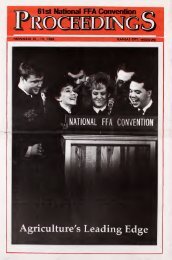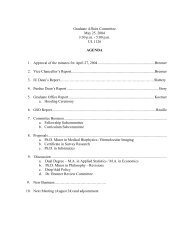Create successful ePaper yourself
Turn your PDF publications into a flip-book with our unique Google optimized e-Paper software.
Take<br />
right<br />
fhe<br />
When receiving the ball, lean<br />
forward with arms outstretch-<br />
ed, palms turned slightly up.<br />
one short step with the<br />
foot, a full step with<br />
left, and then kick ball.<br />
Hk *^^i^^i<br />
46<br />
Meet the ball about knee high.<br />
Swing the kicking leg forward<br />
with knee slightly bent, toe<br />
extended and turned In to you.<br />
A GOOD<br />
HOW<br />
TO<br />
PUNT<br />
By<br />
Haymond Svhiiessler<br />
PUNTER has got to<br />
have good leg drive and coordi-<br />
nation." says Lou Groza. "It<br />
helps to have long legs, but most of all<br />
it takes proper technique. A lot of<br />
little guys can kick the ball a mile because<br />
they studied good form. Good<br />
form, like in golf, can make an excellent<br />
punter out of any ordinary kicker if he<br />
can learn the rhythm."<br />
A good punter must kick the ball<br />
long, high and accurate. Before the<br />
ball is snapped, make sure you are relaxed.<br />
If you feel too tense, shake your<br />
hands and open your mouth slightly.<br />
Many coaches will start their rookies<br />
on learning techniques first without the<br />
.^ As foot meets ball, straighten<br />
knee with quick snap. Keep your<br />
head down until ball is on way.<br />
Be sure to follow through after<br />
kicking the ball. The leg must<br />
be kept straight and allow it to<br />
reach even higher than the head.<br />
ball. Then the ball is kicked to a teammate<br />
at 15 yards so timing and accuracy<br />
can be studied. Only after this is<br />
mastered are the kickers allowed to<br />
boot for distance.<br />
Stand in an easy relaxed manner with<br />
the kicking leg slightly forward, perhaps<br />
three or four inches. Lean forward with<br />
both arms outstretched— palms turned<br />
somewhat upward. If possible, the ball<br />
should be delivered to you slightly<br />
above your right knee.<br />
As soon as the ball is caught, adjust<br />
it, placing the laces on top or to the<br />
right. The right hand will be spread<br />
somewhat under the ball, the left hand<br />
a few inches ahead of the right. Remember,<br />
you will have two seconds at<br />
the most in which to get rid of the ball.<br />
Meet the ball about knee high. The<br />
kicking leg is swung forward with the<br />
knee slightly bent, toe extended and<br />
turned in. As the foot meets the ball,<br />
the knee is straightened with a quick<br />
snap and the ankle is forcibly extended<br />
and locked. It is this final snap that<br />
will give you extra distance. To make<br />
the ball spiral, you must meet the ball<br />
with the outside of the instep on the<br />
belly of the ball. Most punts will<br />
bounce in the direction they are spin-<br />
ning, so allow for this when kicking for<br />
the sidelines.<br />
Many times you will be forced to<br />
place your kick to the sidelines. To do<br />
so. turn your body in the direction you<br />
wish the ball to go. Place the toe of<br />
your kicking foot on your second step<br />
exactly in the direction of your target.<br />
You have only two seconds in which<br />
to get the kick off. Keep this time element<br />
in mind even when you practice.<br />
Punters, like all ball players, some-<br />
times fall into a slump. If you do.<br />
remember to do what the stars do: Go<br />
back to the fundamentals and review<br />
every little movement until you have<br />
found vour trouble.<br />
The <strong>National</strong> FUTURE FARMER
















